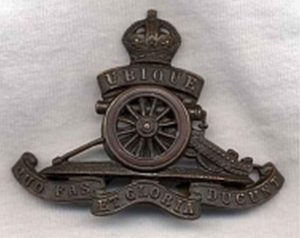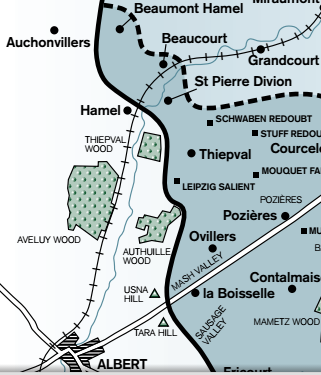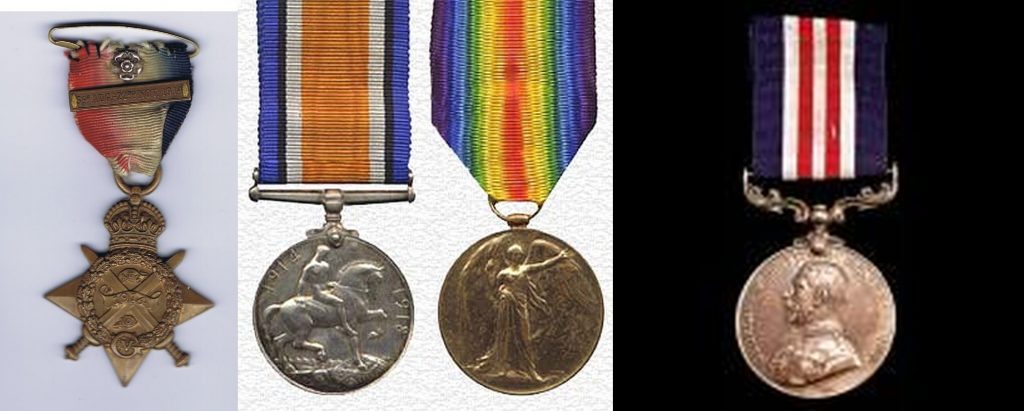Albert Edward Blinco MM [4386]
1892-1976
Father Nm: James Thomas Blinco, b. 8 May 1861, Wexham, Buckinghamshire, England d. 23 Nov 1925, Eton, Buckinghamshire (Age 64 years): Oldest known ancestor William Blincko 1635 Hedgerley.
Mother Nm: Harriet Jane Chapman, b. Jan 1867, Woking, Surrey, d. 1 Jan 1951, Langley Buckinghamshire (Age ~ 83 years)
Marriage Dt: Marriage Dt:1924 to Evelyn M Elston, Eton 3a 2077.
K comments: Brothers who served in WW1;
- Moses Henry Oxford and Bucks LI died of wounds in 1916.
- James Thomas with the Royal Fusiliers pre-war and the RGA in the war.
- William served with RGA.
- Charles William served with 2nd Ox. & Bucks Light Infantry, Army Cyclist Corps.

WW2: Son Albert Dennis was KIA in 1944. Nephew Charles JF served with RAF
Spouse Comments: Evelyn May Elston [7896] born 16.3.1896 died Mar 1974 Eton
Children: Albert Dennis 1925-1944.
(Research): GR[B] Eton March 1892 GR[D] Slough vol 19 p 0763 March 1976.
1901 Census Langley Bucks
- Blinco Harriet Wife F 1867 Guildford 34
- Blinco James T Head Market Gardener M 1862 Langley 39
- Blinco Albert Son M 1893 Langley 8
- Blinco Charlie Son M 1897 Langley 4
- Blinco Lily Dau F 1900 Langley 1
- Blinco William Son M 1898 Langley 3
- Blinco James T Son M 1891 Langley 10
- Blinco Moses Son M 1895 Langley 6
1911 Census Eton Buckinghamshire
Blinco Harriet Wife Housekeeper F 1866 Guildford 45
- Blinco James Head Farm Labourer M 1862 Wexham 49
- Blinco Albert Son Bread, Biscuit, Cake Maker M 1892 George Green 19
- Blinco Charlie Son Others Engaged In-Service M 1896 George Green 15
- Blinco Lily Dau F 1900 George Green 11
- Blinco William Son M 1898 George Green 13
- Blinco James Son Builders Labourer M 1891 George Green 20
1911
- 11 July. Attested with Royal Horse Artillery at Woolwich age 19 years.
 |
 |
| Royal Horse Artillery | Royal Artillery |
WW1
Blinco Albert Edward 1892, Eton, Driver, 66358, 1006673, ‘O’ and ‘G’ Battery ‘V’ Bde. Royal Horse Artillery, Royal Field Artillery.
Synopsis
Albert joined the war very early and saw it out the full term being wounded at least twice and in both cases, it seems from gas shelling. he appears to have been with the same RHA Brigade throughout the war and may have been with the same battery ‘O’ all that time.
A Battery driver in the RHA had the very dangerous job of hauling ammunition from the ammunition park to the Gun placements, Undoubtedly in the early years, this was a Horse-drawn train and may have been through to the end.
Sometime prior to August 1918 Albert performed an act of bravery that was recognised with the Military Medal. I believe I may have pinpointed this event from looking at the Brigades activities. On 2nd August 1917 at Passchendaele in atrocious conditions, the V Bde was having great difficulty setting up guns for registration in the mud, when disaster struck. A shell fire in the ammunition wagons killed the quartermaster and 11 men were wounded. The diary says no more than the ammunition was brought up on Pack Horses, I think Albert is a driver it is logical that he took up this dangerous task as the V Bde was under extreme danger and thus earned his recommendation for the Military Medal. If however this wasn’t to action it may still have been at Passchendaele as the V Bde pinned down at the Canal Bank (Trench Map Ref 28 NW2B6.c.2.7) for many days and casualties were heavy.
Initially, records had given Albert being with C Battery however war diary records show this is wrong it was likely G Battery (a recording error) The record referred to his being wounded by a Gas shell at the Battle of Amiens in August 1918
In 1919 Albert appears to be very comfortable in the Army and transfers to the RFA to take up his pre-war trade of Baker and stays with the Army until 1923. Note: Many men did this as work was hard to find after the war.
1914
- 15th Nov. The medal card informs that Albert entered the field of war in France on 15th Nov 1914. His Gun Battery is given as “O”. This battery was part of V Brigade of the RHA.
Note:
The basic unit of the Royal Artillery was and is the Battery. A battery included 5 officers and 200 men, 228 horses and six 13-pounder field guns.
When grouped together they formed brigades, in the same way, that infantry battalions or cavalry regiments were grouped together in brigades. At the outbreak of World War I, a field artillery brigade of headquarters (4 officers, 37 other ranks), three batteries (5 and 193 each), and a brigade ammunition column (4 and 154)[2] had a total strength of just under 800 so was broadly comparable to an infantry battalion (just over 1,000) or a cavalry regiment (about 550). Like an infantry battalion, an artillery brigade was usually commanded by a Lieutenant-Colonel.
V Brigade Movements
1914
- At the outbreak of World War I, the brigade was at Ipswich attached to 5th Cavalry Brigade, still commanding G and O Batteries. On 9th October 1914, the newly reformed Z Battery, RHA joined the brigade.
- Z Battery joined 8th Division at Winchester on formation. With 8th Division, it crossed to France on 4th and 5th November 1914 (landing at Le Havre on 6th and 7th November)
- 18th Dec. Neuve-Chapelle Moated Grange Attack.
1915
- 10–13th Mar. The Battle of Neuve Chapelle. Neuve Chapelle was the first planned British offensive of the war. It demonstrated that it was quite possible to break into the enemy positions – but also showed that this kind of success was not easily turned into breaking through them. The main lessons of Neuve Chapelle were that the artillery bombardment was too light to suppress the enemy defences; there were too few good artillery observation points; the reserves were too few to follow-up success quickly; command communications took too long and the means of communicating were too vulnerable. One important lesson was perhaps not fully understood: the sheer weight of bombardment was a telling factor. Similar efforts in 1915 and 1916 would fall far short of its destructive power.

- 9th May. Aubers Ridge.
- 25th Sept. Bois-Grenier.

The Ordnance QF 13-pounder quick-firing field gun was the standard equipment of the British Royal Horse Artillery at the outbreak of World War I. The gun replaced with 18 Pounders from 1915 onwards. Photo courtesy of New York Tribune.
1916
- 1st Jul. The Somme Battle of Albert .
 The 8th Division, which put all its three brigades in the frontline, was to assault the Ovillers spur, the dominating feature immediately north of the Albert to Bapaume road. For the last eight minutes before the infantry assault, that is from 07.22hrs onwards, the final artillery bombardment was supplemented by the fire of trench-mortar batteries from concealed positions near the front, three sections(twelve 3-inch Stokes mortars) to each brigade, which fired eighty to one hundred rounds per mortar on the German front defences…… At 07.30hrs the artillery barrage lifted, the trench mortars ceased fire, and the leading battalions of all three brigades rose and moved forward.1
The 8th Division, which put all its three brigades in the frontline, was to assault the Ovillers spur, the dominating feature immediately north of the Albert to Bapaume road. For the last eight minutes before the infantry assault, that is from 07.22hrs onwards, the final artillery bombardment was supplemented by the fire of trench-mortar batteries from concealed positions near the front, three sections(twelve 3-inch Stokes mortars) to each brigade, which fired eighty to one hundred rounds per mortar on the German front defences…… At 07.30hrs the artillery barrage lifted, the trench mortars ceased fire, and the leading battalions of all three brigades rose and moved forward.1 - 23rd – 30th Oct. Battle of Le Transloy.
1917
- 13th Jan. V Brigade was broken up on 13th January 1917 and the sections returned to their parent batteries. The O and Z Batteries were placed into the Fourth Army Artillery Brigade in January 1917. However, as records show in August 1918 Albert is still with V Brigade but very likely with G Battery. (see war diary wounding Aug 1918)
- 1st and 2nd August. Battle of Passchendaele. Unable to position guns in the mud and register for firing the O Battery returned to the old position opposite Captain Farm here the quartermaster Byrch was killed and 11 men wounded by shell fire in Wagon. Ammunition brought up on packhorse.

Site of the Artillery War Cemetery Captains Farm is 3 kms west of Langemarck and close to Pilkem - 3rd August. Moved back to Canal Bank.
- 5th Aug. Shelled while in the same position at Canal bank. Z Bty casualties were 2 killed and 7 wounded. O Bty 5 wounded.
- 6th Aug. Shelled early morning and casualties amongst 402Bty RFA located in the same spot and O Bty 1 wounded and 1 HQ man also wounded.
- 9th Aug. Concentrated firing. 3 Signallers wounded. 1 man in O Bty and 10 in 402 Bty RFA co-located. This firing pattern and occasional casualties occurred on 16th Aug.
- 16th Aug. The Fifth Army and the French Army on the left attacked The final object of the 14th Corps was achieved 100 yds in front of the ridge overlooking Broombeek. The forward position reconnoitred for forward gun positions.
- 17th Aug. Bde shelled 1 one killed 3 wounded in O Bty.
- 18th Aug Bde heavily shelled O Bty 5 men killed and 4 wounded.
- 26th Aug Bde cooperated in an attack beyond Langmarck. O Bty Casualties 1 officer killed 2 men wounded
- 31st Aug. Bde at rest at Houterkerque.
- October. Returned to the front at Map ref 28 C4 a.4.5
- 9/10th Oct. Bde supported Infantry attack. Two officers were wounded and on 10th Oct. 5 men were wounded from retaliatory fire.
- 18/19th Oct. Intense enemy shelling Casualties amongst O Bty, Z Bty and 402 Bty RFA
- 20th/21st Oct. 43 hrs of bombardment commenced prior to the Infantry attack. Infantry advanced. O Bty casualties for two days 1 killed 12 wounded
- 24, 25th and 26th Oct. Yet another infantry supported the attack. O Bty casualties 6 for the period.
- 29th Oct. The Bde leaves the area and is in Mercatel of the Arras sector, France by 1st Nov.
1918
- 1st Mar. At Riez in the Lens Sector.
- 28thApril. The Bde came under the command of the Australian 2nd Division Artillery They marched to Vadencourt to join the force..
- 6th and 21st May. Wagon lines near Contay were bombed by enemy aircraft. On 21st May 6 men were wounded, two men stayed at duty.

- 8th-10th Jun. The Bde moved to the north of Vaux sur Somme heavy hostile shelling gas and other shells . At 9.45 pm under an artillery barrage, the Australian 2nd Division attacked, which was complete success captured 260 POW’s and 20 machine guns

- 7th Aug.

Note that another Blencowe is recognised with the Military medal this day ie Mervyn Blencowe Awarded Military Medal, gazetted in The Times Aug 7th 1918, Page 4 as AE Blinco RHA (Langley). The action that gained him the MM may be related possibly to the German Spring Offensive when many Artillery guns were overrun.
- 8th-9th. Aug. The Battle of Amiens. Sailly Laurette. V Bde marched to a position near Vaux sur Somme and worked with 53rd Inf. Bde 18th Div. In the attack, the V Bde was to go a position west of Malard Wood. Casualties two men killed. Fighting continued 9th Aug. G Bty advanced and again to the west of Gressaire Wood on the 10th Aug.
- 10th. Aug contd. It’s at this point that Albert was most likely wounded by a gas shell. The war diary says the G Bty. advance was shelled 6OR’s (incl Albert) wounded.
- This photo indicates that by 9th August German Guns had been captured.

- 15th Aug. Albert Blinco ‘G’ Coy 5th Bde. RHA. Admitted from a Casualty Clearing Station to 51st Field Ambulance (17th Div.) with Gas shell wounds and on the same day transferred to another hospital facility.
- From here Albert would have been invalided home to a hospital in England.
1919
- Transferred to Royal Artillery.
- 15th Mar. Albert gave the trade description Baker and moved to that section1.
Sources
- The Royal Artillery Historical Trust.
- V Bde RHA war Diary WO-95-455-1
- Slaughter on the Somme by John Grehan, Martin Mace
- First World War Representative Medical Records of Servicemen NA MH106/113
Medals
Awarded 1914, British War and Victory medals plus the Military Medal (Gazetted 7 Aug 1918).
The Medal Card shows that Albert was awarded the British and Victory medals as well as the Military Medal. (cannot find a citation) The Royal Artillery records show that he was also awarded the 1914 ‘Mons” Star.
Military Medal
First Name(s): A E, Last Name: Blinco, Rank: Driver, Service: Royal Horse Artillery, Date of Gazette:06.08.1918
Year of Gazette:1918, Award: Military Medal, Domicile: Langley, Royal Artillery Military Medals 1916-1993
After the War
1919-1923
Served with the Royal Artillery as a Baker 1006673 until discharged 9th Jul. 1923
1931
Albert was a Market Gardener in Langley Marish, Bucks, UK.
1939 Census
Orchard George Green Eton
Albert E born 5.1.1892 market gardener own account Evelyn M born 17.3.1896 1 undisclosed – Son Albert Dennis age 14
1976 Death age 84 years
Slough, Bucks, UK.
GALLERY
There are 5 image records that are not shown for this man because of copyright protection.










Bucks Roll of Honour 1914-16 Listed only
Bucks Absent Voters List 1918 George Green
Middlesex and Buckinghamshire Advertiser 25/2/16 in France
Slough, Eton & Windsor Observer 4/3/16 serving
Windsor, Eton & Slough Express 18/12/15 Langley roll of honour